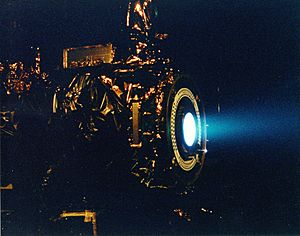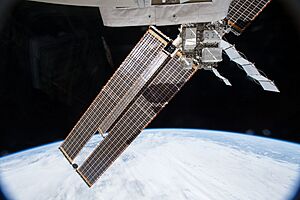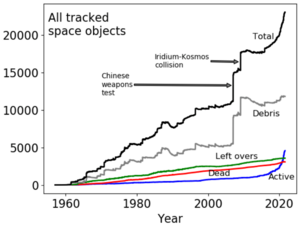Satellite facts for kids
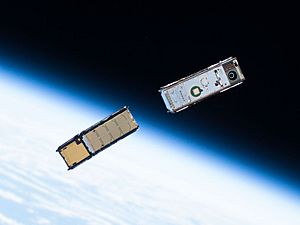
A satellite or artificial satellite is a machine launched into space. It travels in an orbit around a larger object, usually Earth. Satellites help us in many ways. They relay communications, predict weather, guide navigation systems like GPS, and broadcast TV and radio. They also help with scientific research and observing our planet. Some satellites are used for security, like watching for threats or gathering information.
Most satellites need power to work. They often have solar panels that turn sunlight into electricity. Some use special generators called radioisotope thermoelectric generators (RTGs) for power in deep space. Satellites also need to talk to ground stations on Earth. They do this using devices called transponders. Many satellites are built using standard designs, like small CubeSats, to save money and effort. Groups of similar satellites can work together, forming constellations. Because it costs a lot to launch things into space, satellites are made to be as light and strong as possible.
Satellites reach orbit by speeding up or slowing down to the right speed. They must fly high enough to avoid being pulled down by Earth's atmosphere. Once in orbit, satellites can adjust their path using thrusters. About 90% of Earth's satellites are in low Earth orbit or geostationary orbit. Geostationary satellites stay above the same spot on Earth. Some imaging satellites use a Sun-synchronous orbit to see the whole globe with consistent lighting. As more satellites and space debris fill Earth's orbit, the risk of collisions grows. An orbiter is a spacecraft that enters orbit around another planet or moon, becoming an artificial satellite. A few satellites orbit other celestial bodies, like the Moon or Mars.
Earth observation satellites collect information for mapping, weather monitoring, and studying oceans and forests. Space telescopes use the clear view of space to observe distant objects across the electromagnetic spectrum. Because satellites can see large parts of Earth at once, communications satellites can send information to faraway places. The precise timing and predictable paths of satellites are used in satellite navigation systems, such as GPS. Crewed spacecraft like the International Space Station are also artificial satellites.
The Soviet Union launched the first artificial satellite, Sputnik 1, on October 4, 1957. As of June 28, 2025, there are 12,952 satellites orbiting Earth. The United States operates the most, with 8,530. Russia has 1,559, and China has 908.
Contents
Exploring the History of Satellites
Early Ideas for Spacecraft
The idea of an artificial satellite began with Isaac Newton. In 1687, he imagined a cannonball shot so fast it would orbit Earth. This was called Newton's cannonball. Later, in 1903, Konstantin Tsiolkovsky wrote about using rockets to launch spacecraft. He figured out how fast a rocket needed to go to reach orbit.
In 1945, science fiction writer Arthur C. Clarke described how communications satellites could connect people worldwide. He suggested that just three satellites in geostationary orbit could cover the entire planet.
The First Satellites Launched
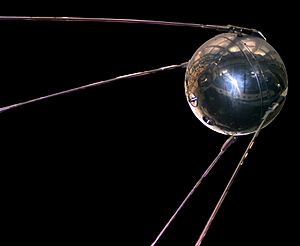
The Soviet Union launched the first artificial satellite, Sputnik 1, on October 4, 1957. It was a big moment in history! Sputnik 1 helped scientists learn about Earth's upper atmosphere. Its launch started the "Space Race" during the Cold War.
On November 3, 1957, Sputnik 2 carried the first living creature into orbit, a dog named Laika.
The United States launched its first satellite, Explorer 1, on January 31, 1958. It discovered the Van Allen radiation belts around Earth. On April 1, 1960, the TIROS-1 spacecraft sent back the first TV pictures of weather from space.
Canada was the third country to build a satellite, though it was launched by an American rocket. France became the third country to launch a satellite using its own rocket. This happened on November 26, 1965, with the Astérix satellite.
Modern Satellite Developments
At first, each satellite was built uniquely. But as technology improved, engineers started using standard designs called satellite buses. This made building satellites faster and cheaper. The first standardized communication satellite was launched in 1972.
Since the late 2010s, many large groups of satellites, called satellite internet constellations, have been launched. Companies now plan for older satellites to safely fall back to Earth when they are no longer needed. The largest artificial satellite ever is the International Space Station.
Today, many small satellites, like CubeSats, are designed to burn up completely when they re-enter the atmosphere. For example, SpaceX Starlink satellites are made to disappear without a trace at the end of their life.
Many countries, including the United States, Russia, China, India, and France, have satellites in orbit. Japan's space agency (JAXA) and NASA are even planning to launch a wooden satellite prototype called LingoSat in the summer of 2024. They are testing how wood holds up in space.
How Satellites Work
Staying in Orbit and Pointing Right
Most satellites use small engines called thrusters to stay in their correct orbit or to move. These thrusters can use chemical fuels or ion thrusters. Ion thrusters are very efficient but produce a tiny push. Satellites also use special wheels, called reaction wheels, to control their direction. This helps them point their antennas or cameras correctly.
Satellites near Earth are affected by Earth's gravity and magnetic field. Satellites farther away are more influenced by the Moon and Sun. Without proper control, satellites cannot communicate with ground stations.
Powering the Satellite
Most satellites get their power from solar panels. These panels collect sunlight and turn it into electricity. Solar panels can rotate to always face the sun. Satellites also need batteries to store power. Batteries are used when the satellite is in Earth's shadow or during launch. Lithium-ion batteries are commonly used today. For satellites traveling far from the sun, radioisotope thermoelectric generators (RTGs) provide power.
What Satellites Are Used For
Watching Our Planet

Earth observation satellites are like eyes in the sky. They monitor and survey Earth, a process called remote sensing. Many are in low Earth orbit for clear pictures. Some are in geostationary orbit for constant views of one area. These satellites help us with mapping, environmental monitoring, and weather forecasting. They can have cameras, radar, or other tools.
Weather satellites watch clouds, city lights, fires, and pollution. They track snow, ice, and ocean currents. Environmental satellites detect changes in plants, air quality, and sea conditions. This helps us monitor droughts and pollution.
Connecting the World
Communications satellites act like giant relay stations in space. They receive signals from one part of Earth and send them to another. This allows us to make phone calls, use the internet, and watch TV across long distances.
Satellites for Security
Some Earth observation or communication satellites are used for military or intelligence purposes. These are sometimes called security or reconnaissance satellites. They can provide early warnings of missile launches or detect nuclear explosions. They also help with electronic surveillance and taking pictures or radar images for monitoring.
Finding Your Way
Satellite navigation systems, like GPS, use satellites to help you find your exact location. These satellites send out radio signals with precise timing. Receivers on the ground use these signals to calculate their position, often within a few meters.
Telescopes in Space
Space telescopes are satellites designed to observe distant planets, galaxies, and other objects in space. Famous examples include the Hubble Space Telescope and the James Webb Space Telescope. They give us amazing views of the universe without Earth's atmosphere getting in the way.
Special Purpose Satellites
- Tether satellites are connected to another satellite by a long, thin cable.
- Biosatellites carry living organisms for scientific experiments.
- Scientists are even proposing Space-based solar power satellites to collect solar energy and send it to Earth.
Satellites and Space Safety
Satellites can be used for security and defense. However, there have been instances where satellites were used for unauthorized purposes, like spreading messages or trying to get secret information. Some countries have also tested ways to stop satellites in orbit. For example, in 2007, the Chinese military shot down an old weather satellite. In 2008, the US Navy shot down a defunct spy satellite. India also demonstrated this capability in 2019. These actions raise concerns about space safety and the creation of more space debris.
Environmental Impact of Satellites
The environmental effects of satellites are becoming more important to understand. This is because more and more satellites are being launched.
Using Earth's Resources
Building satellites and rockets requires many materials. Aluminium is often used because it's light and strong. Mining and refining aluminum can harm the environment. Satellites also use rare elements like lithium and gold. Getting these elements can have significant environmental impacts. Rocket parts, especially the large booster stages, are often dropped into the ocean after launch and are not usually recovered.
Effects of Rocket Launches
Rocket launches release various pollutants into the atmosphere. These include black carbon, CO2, and nitrogen oxides. The type of fuel used affects the pollutants released. While the amount of greenhouse gases from rockets is small compared to other industries, like aviation, it's still a factor.
Pollutants released high in the stratosphere can affect the ozone layer. The ozone layer protects us from harmful UV radiation. Scientists are studying these effects, but current understanding suggests that launch rates would need to increase significantly to cause major ozone depletion.
Satellites in Operation
Low Earth Orbit Satellites
Satellites in Low Earth orbit (LEO) are constantly affected by tiny amounts of atmosphere. To stay in orbit, they sometimes need to fire their thrusters. These thrusters release gases like ammonia and nitrogen into the upper atmosphere. Also, the harsh space environment causes the outer materials of satellites to break down. This can release gases like CO2 into the atmosphere.
Impact on the Night Sky
With so many new satellites, hundreds may soon be visible in the night sky. This increased brightness could confuse animals, like insects and migrating birds, that use celestial patterns for navigation. It might also change how people connect with nature and the night sky.
Ground Support Infrastructure
Satellites need ground stations and facilities to monitor and control them. The environmental cost of building and operating this ground infrastructure is also a factor that needs more study.
What Happens When Satellites Die
When satellites reach the end of their life, they are either guided to fall back into Earth's atmosphere or moved to a "graveyard orbit" far from Earth. Most satellites burn up during re-entry due to the intense heat. This process introduces more materials and pollutants into the atmosphere. There are concerns about potential damage to the ozone layer.
Some older satellites used special power sources. If these satellites fell back to Earth without control, they could cause environmental concerns. Examples include Kosmos 954 and Kosmos 1402.
Reducing the Impact
One idea to reduce pollution and debris is to use new materials. For example, using wood for satellites is being explored. Wooden satellites would burn up more cleanly when they re-enter the atmosphere.
Challenges in Space
Collision Risks
Space debris are pieces of old satellites, rockets, and other junk orbiting Earth. This debris poses a danger to working spacecraft and satellites. If too many collisions happen, it could create a chain reaction, making space unusable. This is known as Kessler syndrome.
The growing number of satellite constellations, like SpaceX Starlink, is increasing orbital pollution. Astronomers are concerned that these bright satellites interfere with observing the night sky. Scientists are working on ways to reduce these negative effects on astronomy.
Radio Interference
Satellite signals can be very weak when they reach Earth. This makes them vulnerable to jamming from land-based transmitters. GPS signals, satellite phones, and TV broadcasts can all be affected.
It's also possible for ground stations to accidentally send signals to the wrong satellite or frequency. This can interfere with legitimate satellite communications. Satellite operators now use advanced tools to find and manage these interference sources.
Managing Space Activities
Issues like space debris, radio interference, and light pollution are growing. There is a need for more national and international rules to manage these challenges.
How Satellites Are Operated

Operating satellites requires more than just building and launching them. It also needs a ground segment infrastructure. This includes control centers and antennas on Earth that communicate with the satellites.
See also
 In Spanish: Satélite artificial para niños
In Spanish: Satélite artificial para niños
- High-altitude platform station
- Solar aircraft
- Satellite refuelling


